Several steps involved in intrascleral sutureless three-piece IOL fixation combined with PK
Long-term follow-up is needed to assess the overall safety of this surgical technique.
Surgical correction of aphakia in an eye without capsular support with a failed corneal graft requires a secondary IOL placement that is stable, along with penetrating keratoplasty as a combined surgical procedure. The surgical approaches in these cases include the use of an anterior chamber IOL, iris- or scleral-sutured lenses, iris-claw lenses and sutureless intrascleral fixation of a three-piece posterior chamber IOL, also referred to as glued IOL.
Of these various techniques for secondary IOL placement, angle-supported anterior chamber IOL implantation is a surgically easier technique, but it can be associated with multiple potential complications related to the iridocorneal angle and have a negative impact on the corneal endothelium over time. Transscleral fixation of a posterior chamber IOL using sutures can be surgically demanding in some cases, and long-term suture degradation and IOL subluxation or dislocation are potential downsides to this approach. Artisan aphakic lenses (Ophtec) have been implanted and attached to the anterior iris surface in aphakic eyes, or IOLs have been sutured to the iris. Anterior or posterior iris attachment of IOLs requires adequate iris tissue and may have other complications such as pupillary distortion, iris-related inflammation and tissue degradation, and may have an impact on endothelial cells. Intrascleral IOL haptic fixation eliminates the need for sutures; however, long-term studies and follow-up are essential to assess the overall safety of this surgical technique.
In this column, I describe the surgical steps in performing a sutureless trans-scleral fixation of a three-piece IOL along with PK.
The technique
The anesthesia may be general anesthesia or monitored anesthesia care, depending on surgeon and patient preference. A temporal approach is used on the only functioning eye of a patient with a failed corneal graft, aphakia, previous retinal detachment, retinal detachment surgery with silicone oil and subsequent silicone oil removal. The temporal approach provides easy access to the vertical meridian (12 o’clock to 6 o’clock) IOL placement (Figure 1).
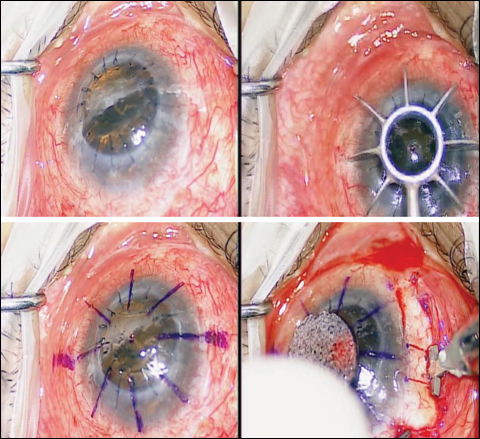
Images: John T
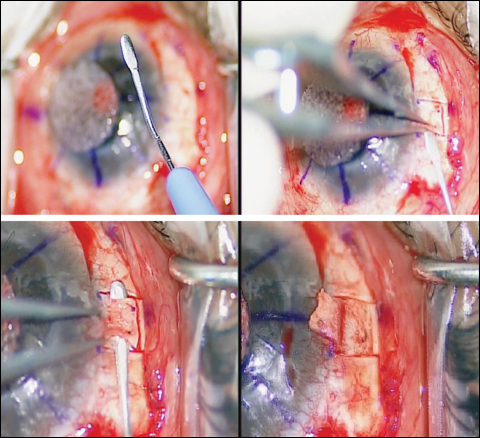

The central cornea is measured with calipers, and a central dot is placed and used for proper centration of the eight-bar radial marker (Figure 1). The superior (12 o’clock) and inferior (6 o’clock) vertical meridians are marked on the conjunctival surface using a marking pen as extensions of the vertical meridian, and a diamond blade is used to create a partial-thickness limbus-based lamellar scleral flap measuring 2.5 mm × 2.5 mm (Figure 1). A Sharpoint mini-crescent knife (Surgical Specialties) is used to dissect a partial-thickness scleral flap using the 2.5 mm scleral square outline, and the superior margin of the scleral flap is dissected free toward the end of the dissection (Figure 2). Similarly, a second scleral flap is created at the 6 o’clock position (Figure 3).
Using a sterile marking pen, a dot is placed on the center of the scleral bed at a distance of 1.5 mm from the limbus, and a second dot is placed on the inferior margin of the scleral flap parallel to the first dot and serves as the entry point for the haptic into the scleral tunnel (Figure 3). A bent 26-gauge sterile needle is passed parallel to the limbus starting at the second dot, creating an intrascleral tunnel that is parallel to the limbus and in the direction of the inferior haptic of the IOL that is to be externalized in subsequent surgical steps. It is preferable to create the tunnel at this time before opening the globe (Figure 3). A narrow probe is passed into the scleral tunnel before intrascleral housing of the IOL haptics (Figure 3).
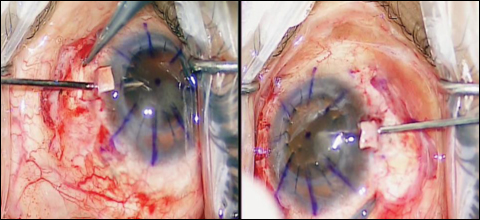
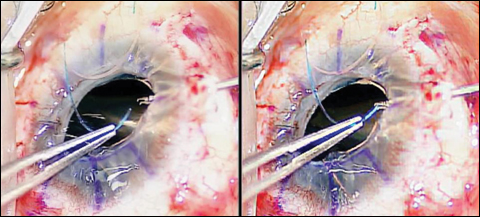


A 23-gauge needle is used to create a sclerostomy at the 6 o’clock position by passing the needle tip via the pre-placed dot on the central region of the scleral bed located 1.5 mm from the limbus, and a second sclerostomy is created at the 12 o’clock position beneath the scleral flap. These sclerostomies are created before the open-sky technique of the PK, thus providing proper resistance to the intraocular needle entry (Figure 4). Smooth tying forceps hold the IOL haptic, while the surgeon’s right hand introduces 25-gauge MST forceps through the sclerostomy at the 12 o’clock position; the open tips of the microforceps are clearly visible through the corneal open-sky approach (Figure 5). The tip of the IOL haptic is grasped by the microforceps. This open-sky approach does not require a third hand from a surgical assistant to complete the procedure (Figure 5).
Using the smooth tying forceps and the microforceps, the superior haptic of the IOL is fully externalized via the 12 o’clock sclerostomy site (Figure 6). The inferior IOL haptic is externalized using the microforceps via the 6 o’clock sclerostomy site beneath the scleral flap. Once the inferior haptic is held by the microforceps, the surgeon uses his right hand to hold the superior haptic firmly, before the inferior haptic is pulled through the inferior 6 o’clock sclerostomy. This ensures protection against any accidental pull through of the superior haptic into the eye and also eliminates any need for an extra assistant’s hand during this maneuver (Figure 7).
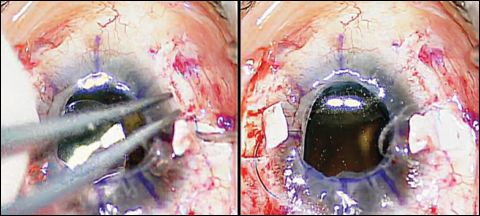


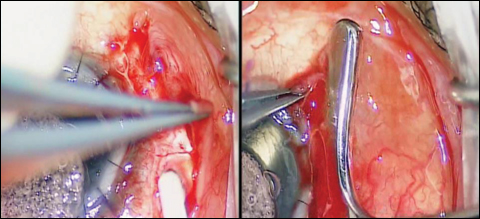
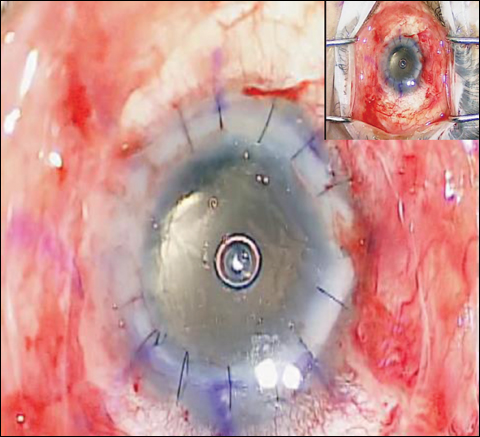
Figure 8 shows the IOL haptic being fed into the scleral tunnel at the 12 o’clock location using microforceps and the fully seated superior haptic within the scleral tunnel. Also seen is the externalized inferior IOL haptic (Figure 8). Similarly, the inferior IOL haptic is fed into the scleral tunnel running parallel to the limbus in a counterclockwise direction (Figure 9). The inferior haptic lies beneath the scleral flap and is housed intrasclerally (Figure 9). Using the Mastel illuminating surgical keratoscope, corneal astigmatism is decreased by suture tension adjustment and/or suture addition or removal as needed (Figure 10). The scleral flaps are not closed until after the completion of the PK, as this allows for any final IOL adjustment if required to optimize IOL centration (Figure 10). Tisseel fibrin glue (Baxter) is used to seal the sclerostomies, scleral flaps and conjunctiva, and a muscle hook is used to uniformly attach the conjunctiva and Tenon’s tissue to the underlying sclera (Figure 11). Figure 12 shows the low- and higher-power intraoperative views of the PK combined with sutureless intrascleral haptic fixation of a three-piece posterior chamber IOL.
Surgical pearls
1. A temporal approach provides easier access to the vertical 12 o’clock to 6 o’clock meridian and makes it easier to dissect the scleral flaps.
2. I prefer the vertical meridian to the horizontal meridian because this approach provides the maximum length of the externalized IOL haptic. Three-piece IOLs are 13 mm in length, and the power ranges differ depending on the IOL type.
3. Create the flaps, scleral tunnels and sclerostomies before opening the globe for the PK as this provides adequate resistance during these surgical steps.
4. Hold the superior haptic with the right hand while externalizing the inferior haptic to prevent accidental slippage and intraocular retraction of the superior haptic.
5. There is no need for an assistant during this combined surgical procedure.
6. Close the scleral flaps last after the PK, thus allowing any final IOL adjustments that may be required for optimal IOL position.
7. Use a 23-gauge needle sclerostomy when using 25-gauge microforceps and a 20-gauge sclerostomy when using 23-gauge microforceps.
8. Use fibrin glue to seal the sclerostomies and scleral flaps to avoid potential leakage or postoperative hypotony.
9. Because it is an open-sky technique, a non-foldable three-piece IOL is chosen.
- References:
- Ashok Kumar D, et al. Eye Contact Lens. 2014;doi:10.1097/ICL.0000000000000039.
- Kara N. J Refract Surg. 2015;doi:10.3928/1081597X-20150623-08.
- Kumar DA, et al. Ophthalmology. 2015;doi:10.1016/j.ophtha.2014.07.032.
- McKee Y, et al. J Cataract Refract Surg. 2014;doi:10.1016/j.jcrs.2014.04.027.
- For more information:
- Thomas “TJ” John, MD, a clinical associate professor at Loyola University at Chicago and in private practice in Oak Brook, Tinley Park and Oak Lawn, Ill., can be reached at email: tjcornea@gmail.com.
Disclosure: John reports no relevant financial disclosures.
